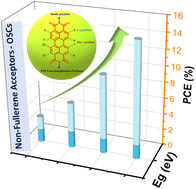Perylene-diimide for organic solar cells: current scenario and prospects in molecular geometric, functionalization, and optoelectronic properties
Abstract
Recent advancements in material design have facilitated the utilization of n-type conjugated molecules as solution-processed non-fullerene acceptors (NFAs), offering promising alternatives to conventional fullerene acceptors (FA) in organic solar cells (OSCs). This comprehensive review aims to shed light on the significant design concepts of perylene-diimide (PDI) chromophores, focusing on functionalized small molecule non-fullerene acceptors (SM-NFAs), which demonstrate high performance in OSCs. The PDI chromophore is systematically classified into mono, di, tri, and tetra PDI functionalized small molecule architectures, enabling a multidisciplinary exploration encompassing molecular structure, optical properties, electronic structure, and device performance within the scope of this review. Specifically, this review thoroughly discusses influential factors, such as rational design principles, diverse grafting sites for structural modifications, cutting-edge synthetic techniques, precise morphological control, and meticulous device optimization, all of which contribute to the advancement of PDI-based SM-NFAs in the next-generation materials category for OSCs. The proposed architectural configuration holds significant promise in facilitating roll-to-roll compatible OSCs that can achieve enhanced device performance. In the final chapter, we address chiral optics, organic photodetectors, sensors, and medical fluorescence imaging as PDI organic small molecules beyond OSCs to grasp the reader's knowledge. Furthermore, this review highlights the intricate interplay among the linear, bridged, and fused-ring types and the strategic linking positions of SM-NFA PDIs within high-performance NFAs, thereby elucidating their profound impact on photovoltaic properties based on more than 300 PDI derivatives. By effectively demonstrating the superior service performance and stability of PDIs-NFAs compared to conventional FA-based OSCs, this review substantiates the expectation that the forthcoming generation of PDIs-NFAs will exhibit notably improved optoelectronic performance.

- This article is part of the themed collection: Journal of Materials Chemistry A Recent Review Articles


 Please wait while we load your content...
Please wait while we load your content...